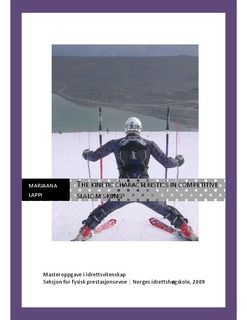The kinetic characteristics in competitive slalom skiing
Master thesis
Permanent lenke
http://hdl.handle.net/11250/171438Utgivelsesdato
2009Metadata
Vis full innførselSamlinger
Sammendrag
The purpose of the present study was to quantify and describe ground reaction forces in
competitive slalom skiing. Background: Recent alpine skiing research has measured forces
in skiing using instrumentation which interferes to some extent with skiing technique.
Instead, the rationale of this study was to estimate kinetic characteristics in competitive
slalom skiing using plantar pressure measurement which minimizes technical interference
and then to compare force characteristics in two courses typical of competitive slalom skiing.
The specific research question was: What are the kinetic characteristics, force distribution
and chatter in a slalom turn? Methods: 11 highly skilled, Norwegian male skiers were
assessed through 5 left and 5 right slalom turns in the mid-portion of two race training
courses with linear distances between gates of 10 and 13 meters. They were equipped with
Pedar Insoles (Novel GmbH, Munich, Germany) from which ground reaction forces were
determined and analyzed for kinetic characteristics. Descriptive statistics, t-tests, two-way
repeated measures ANOVA and Pearson’s and partial correlation were used to compare the
two courses and turn directions and to check for relationships. Kinetic characteristics of
slalom turns were subject-specific. No significant differences were found in the magnitude of
ground reaction forces between courses or turn directions. Timing of gate passing and the
apex were significantly later on the 13 meter course, and the timing of apex was later in turns
to the right-regardless of the course. Significantly greater chatter of the inside ski was found
on the 10 meter course. Significance: The Pedar insole system provides useful knowledge
enabling coaches to give precise technique suggestions to their athletes.
Beskrivelse
Masteroppgave – Norges idrettshøgskole, 2009.
